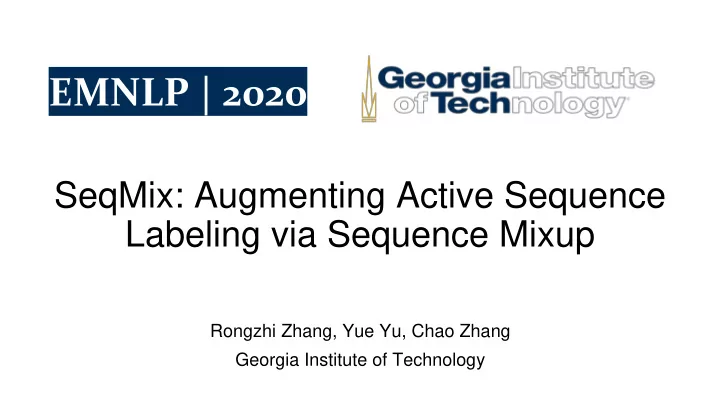

EMNLP | 2020 SeqMix: Augmenting Active Sequence Labeling via Sequence Mixup Rongzhi Zhang, Yue Yu, Chao Zhang Georgia Institute of Technology
Introduction Sequence labeling is core to many NLP tasks. ● Part-of-speech (POS) tagging. ● Event extraction. ● Named entity recognition (NER). ● Neural sequential models have shown strong performance ● for sequence labeling but they are label hungry.
Active Sequence labeling Active learning is suitable for sequence labeling in low-resource scenarios. ● Train Run Add sample Sample However, existing methods on active sequence labeling use queried data ● samples alone in each iteration. The queried samples provide limited data diversity. ● Using them alone is an inefficient way of leveraging annotation. ● We study the problem of enhancing active sequence labeling via data augmentation.
Challenges We need to jointly generate sentences and token-level labels. ● Prevailing generative models are inapplicable. -- They can only generate word sequences without labels. ● Heuristic data augmentation methods are infeasible. -- Directly manipulating tokens such as context-based words substitution, synonym replacement may inject incorrectly labeled sequences into training data.
Our Solution ● SeqMix searches for pairs of eligible sequences and mixes them both in the feature space and the label space. Labeled Pairing Paired Generated data function samples sequences ● Deploy a discriminator to judge if the generated sequence is plausible or not. Eligible Generated Discriminator generations sequences
Method Overview Paring function 𝜂(⋅) Labeled set ℒ Unlabeled set 𝒱 newly labeled Generated Paired samples data sequences Active query policy 𝜔(⋅) top K samples Eligible Discriminator generations Data 𝑒(⋅) annotation augmentation data Labeled sequence newly labeled data labeled data fitted model Unlabeled sequence Active learning model 𝜄 Mixed sequence
Sequence Mixup in the Embedding Space ● The input space is discrete for text, so we make linear interpolation in the embedding space. ● Given two sequences 𝑦 𝑗 and 𝑦 𝑘 , the mixing process at the t-th position: where 𝑓 𝑢 is the mixed embedding, 𝑧 𝑢 is the mixed label, ℰ is the pre- defined embedding list and the mixing coefficient 𝜇 ∼ 𝐶𝑓𝑢𝑏 𝛽, 𝛽 .
Whole-sequence Mixup • Perform sequence mixing at the whole-sequence level. • May include incompatible sub-sequences and generate implausible sequences. 1. Sequence length 𝑡 = 5 , valid 3 label density threshold 𝜃 0 = 5 . 2. Red solid frames indicates the whole sequences with same length and valid label density 𝜃 ≥ 𝜃 0 get paired.
Sub-sequence Mixup • Require the sub-sequences of two input sequence are paired. • Keep the syntax structure of the original sequence, while providing data diversity. 1. Sub-sequence length 𝑡 = 3 , valid 2 label density threshold 𝜃 0 = 3 . 2. Red solid frames indicates the sub-sequences with same length and valid label density 𝜃 ≥ 𝜃 0 get paired.
Label-constrained sub-sequence Mixup • A special case of the sub-sequence mixup. • Further require the labels of sub-sequences are consistent. 1. Sub-sequence length 𝑡 = 3 , valid 2 label density threshold 𝜃 0 = 3 . 2. Red solid frames indicates the sub-sequences with same length, consistent labels, and valid label density 𝜃 ≥ 𝜃 0 get paired.
Scoring and Selecting Plausible Sequences ● To maintain the quality of mixed sequences , we set a discriminator to score the perplexity of the sequences. ● Utilize a language model to score the sequence 𝑌 by computing its perplexity. ● Based on the perplexity and a score range 𝑡 1 , 𝑡 2 , give judgement for the sequence 𝑌 .
Experiments ● Datasets ● CoNLL-03 -- a well studied dataset for NER task ● ACE-05 -- a well-known corpus for automatic content extraction ● WebPage – a tiny NER corpus comprise of 20 webpages ● Baseline ● 4 active learning methods ● Evaluation ● Set 6 data usage percentiles for the training set, calculate 𝐺 1 score for each data usage percentile.
Main Results ● SeqMix consistently outperforms the baselines at each data usage percentile. ● The augmentation advantage is especially prominent for the seed set initialization stage where the annotation is very limited.
Enhance different active learning policies The improvements to different active learning approaches provided by SeqMix. • SeqMix is generic to various active learning policies. • For random sampling, LC sampling and NTE sampling, the averaged performance gain is {2.46%, 2.85%, 2.94%} .
Ablation Study: Effect of Discriminator The performance of SeqMix with variant discriminator score range ● The score range 0, +∞ indicates no discriminator participated. ● The comparison demonstrates the lower the perplexity, the better the generation quality.
Case Study: The Generation Process 2 ● Sub-sequence length 𝑡 = 3 , valid label density threshold 𝜃 0 = 3 , the perplexity score threshold is 500. ● Generated sequence 𝑗 with perplexity score 877 is discarded. ● Generated sequence 𝑘 with perplexity score 332 is accepted.
Summary ● We propose a data augmentation method SeqMix to enhance active sequence labeling ● Data diversity introduced via the sequence Mixup in latent space. ● Plausible augmented sequences generated. ● Generic to various active learning policies. ● Future Work ● Implement SeqMix by using the combination of a multi-layer representation of language models. ● Harness external knowledge for further improving the diversity and plausibility of the generated data. ● Code ● https://github.com/rz-zhang/SeqMix
Recommend
More recommend